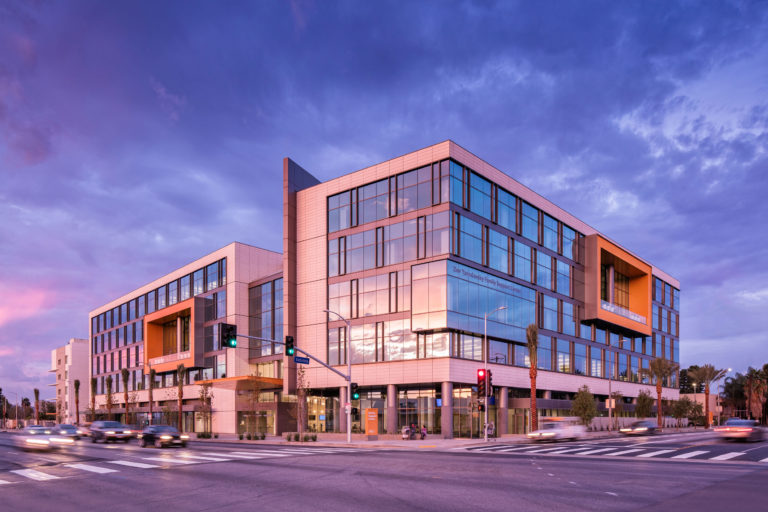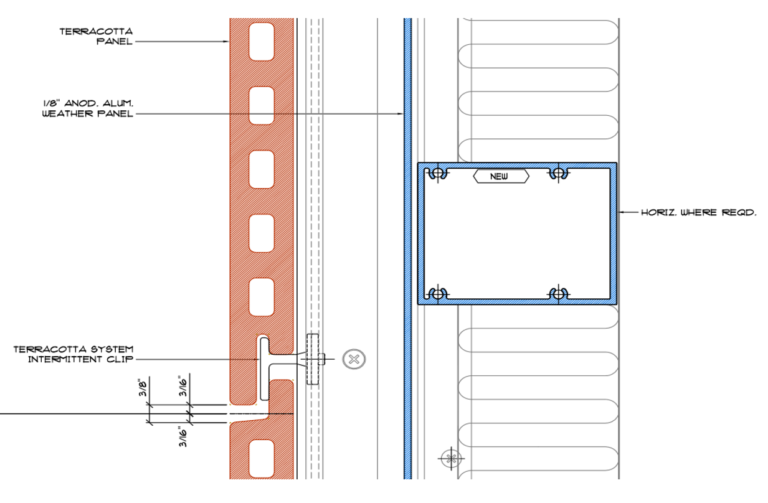
The project delivery method is a common topic of discussion in our evolving industry and can be pivotal in success and failure. In this SCGMA Case Study, we chose to highlight how the delivery method of the façade was a significant influence in the construction of a major Los Angeles County build-to-suit project with an aggressive delivery schedule.
A High-Performance Public Facility
The Zev Yaroslavsky Family Support Center is one of its kind in Los Angeles County, housing seven public, social, and health service agencies in one integrated facility. Completed in late 2015, this five-story, 216,000-square-foot structure serves more than 1,000 area residents each day.
Design-Build Delivery
The LA County Department of Public Works chose Design-Build as a delivery method. The primary objective was to bring the best available designers and contractors to address unique challenges, collaborating with the County to successfully meet the County’s criteria. The County selected Pankow Builders’ team with HKS Architects, along with many other top-tier supporting Design-Build specialty subcontractors.
Unique Façade Challenges
The Pankow / HKS design submission included a unique façade that integrated a glazed curtain wall along with terracotta, dimensional stone, and metal panel finishes. The façade systems’ complexity necessitated the Design-Build team to bring Architectural Glass & Aluminum (AGA), an SCGMA member, on board early in the process. AGA provided a guide to the design challenges and secured the cost early in the process for a significant piece of the project.
The design team’s initial concept was to work with a glazed, unitized curtain wall placed directly adjacent to the other finishes’ rainscreen applications. Upon reviewing the structural frame seismic and live loads requirements, it became apparent that these rainscreen systems would require large joints to accommodate the movement.
“This was not desirable to HKS and would have had a significant impact on the façade aesthetics,” said Thom Greving, HKS principal and Design Director. “Working with the team, AGA’s design-engineering group was able to integrate all these elements into one curtain wall assembly.”
First, the initial glazed curtain wall design integrated shadowbox panels so the spandrel glass to vision glass aesthetics appeared monolithic, then added “feature frames” and horizontal sunshades that HKS desired to provide visual interest. Metal panels were converted into a “glazed-in” application, then recessed liner panel details were added behind the stone and terracotta, providing a rainscreen within the unitized curtain wall frames. The result was that all assemblies moved in unison with most joints gasketed and no greater than ½” in width.

Quality Fabrication, Accelerated Installation
The Pankow Design-Build team committed to an aggressive project schedule, which was aided by the curtain wall systems’ pre-assembled nature.
“We found that the high degree of shop-controlled assembly and glazing of this curtain wall led to a superior quality product,” said Peter Loeb, Pankow Project Executive. “In addition to an excellent fit and finish, the curtain wall installation was able to meet the needs of the accelerated project schedule.”
Because of the curtain wall units’ weight and the position of the building right on Van Nuys Boulevard, AGA installed them utilizing a mobile crane. At times, this required the crane to “fly” the units over the entire structure as setting occurred directly adjacent to busy streets.
Lessons Learned
“Our process on the facade was less about lessons learned and more about experiencing all of the benefits of a solid Design-Build team,” said Thom Greving. “Being able to collaborate with the fabricators so early in the design process to develop the actual unitized façade details allowed the team to deliver a highly articulated curtain wall system very efficiently providing the best value for our client.”
“It’s my opinion that achieving this level of façade design the prescribed timeframe would not have been possible in a conventional delivery.”
Results
In addition to creating a world-class facility, the project was completed on time and under budget.
“The complexity of today’s facades requires that you really need to find the right trade partner in order to be successful,” said Peter Loeb. “AGA proved themselves to be a worthy team partner for this project.”
The project was ultimately named the Zev Yaroslavsky Family Support Center for the District 3 Los Angeles Board of Supervisors member, who championed the project. The project received numerous awards, including the 2016 Engineering News Record California, Best Project, Southern California – Government/Public Buildings, and the 2016 Design-Build Institute of America, National Award of Excellence for Commercial Office Buildings.
SCGMA represents many glazing firms with decades of experience and special talents for finding solutions on the most complex projects. Contact SCGMA to see how our members could assist with your project.
